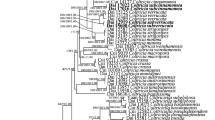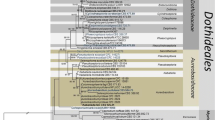Abstract
To explore species diversity of the genus Pseudocosmospora, collections from Beijing and Hubei Province of China were examined, and three undescribed species were encountered. Morphological features and DNA sequence analyses of the ITS, nc LSU rDNA, RPB1, and TUB regions support their placement in Pseudocosmospora and recognition of two new species. Pseudocosmospora curvispora sp. nov. encountered on fruiting bodies of a species of the Diatrypaceae has gregarious, subglobose to obpyriform perithecia seated directly on the host fungus clavate asci, with eight ellipsoidal, smooth ascospores, acremonium- to verticillium-like conidiophores, and strongly curved, allantoid, unicellular conidia. Pseudocosmospora shennongjiana sp. nov. is characterized by solitary to gregarious, subglobose to globose perithecia with a minute basal stroma clavate asci, containing eight ellipsoidal, spinulose ascospores, acremonium-like conidiophores, and rod-shaped, unicellular conidia. An unnamed species of the genus is also described. Distinctions between these species and their close relatives are compared in detail. The previously recorded species of the genus in China are briefly reviewed.




Similar content being viewed by others
Data availability
All specimens and strains are deposited in registered herbaria and culture collection center. Relevant data have been deposited in GenBank, Fungal Names, and TreeBASE.
References
Castlebury LA, Rossman AY, Sung GH, Hyten AS, Spatafora JW (2004) Multigene phylogeny reveals new lineage for Stachybotrys chartarum, the indoor air fungus. Mycol Res 108:864–872
Chernomor O, von Haeseler A, Minh BQ (2016) Terrace aware data structure for phylogenomic inference from supermatrices. Mol Syst Biol 65:997–1008
Cunningham CW (1997) Can three incongruence tests predict when data should be combined? Mol Biol Evol 14:733–740
Gräfenhan T, Schroers HJ, Nirenberg HI, Seifert KA (2011) An overview of the taxonomy, phylogeny and typification of nectriaceous fungi in Cosmospora, Acremonium, Fusarium, Stilbella and Volutella. Stud Mycol 68:79–113
Guu JR, Ju YM, Hsieh HJ (2007) Nectriaceous fungi collected from forests in Taiwan. Bot Stud 48:187–203
Hall TA (1999) BioEdit: a user-friendly biological sequence alignment editor and analysis program for Windows 95/98/NT. Nucleic Acids Symp Ser 41:95–98
Herrera CS, Rossman AY, Samuels GJ, Chaverri P (2013) Pseudocosmospora, a new genus to accommodate Cosmospora vilior and related species. Mycologia 105:1287–1305
Herrera CS, Rossman AY, Samuels GJ, Pereira OL, Chaverri P (2015) Systematics of the Cosmospora viliuscula species complex. Mycologia 107:532–557
Hirooka Y, Kobayashi T, Samuels GJ (2008) Taxonomic studies of nectrioid fungi in Japan. III. The genus Cosmospora. Mycoscience 49:281–290
Lechat C, Fournier J (2020) Pseudocosmospora hypoxylicola (Nectriaceae), a new species from the French Alps. Ascomycete.org 12:6–10
Lee TH, Lu CK, Wang GJ, Chang YC, Yang WB, Ju YM (2011) Sesquiterpene glycosides from Cosmospora joca. J Nat Prod 74:1561–1567
Luo J, Zhuang WY (2008) Two new species of Cosmospora (Nectriaceae, Hypocreales) from China. Fungal Divers 31:83–93
Luo J, Zhuang WY (2010a) Three new species of Neonectria (Nectriaceae, Hypocreales) with notes on their phylogenetic positions. Mycologia 102:142–152
Luo J, Zhuang WY (2010b) Chaetopsinectria (Nectriaceae, Hypocreales), a new genus with Chaetopsina anamorphs. Mycologia 102:976–984
Nakamura T, Suzuki T, Ariefta NR, Koseki T, Aboshi T, Murayama T, Widiyantoro A, Kurniatuhadi R, Malik A, Annas S, Harneti D, Maharani R, Supratman U, Abe J, Kurisawa N, Kimura K, Shiono Y (2019) Meroterpenoids produced by Pseudocosmospora sp. Bm-1-1 isolated from Acanthus ebracteatus Vahl. Phytochem Lett 31:85–91
Nguyen LT, Schmidt HA, von Haeseler A, Minh BQ (2015) IQ-TREE: a fast and effective stochastic algorithm for estimating maximum likelihood phylogenies. Mol Biol Evol 32:268–274
Nirenberg HI (1976) Studies on the morphologic and biologic differentiation in Fusarium section Liseola. Mitt Biol Bundesanst Land Forstw 169:1–117
Nong Y, Zhuang WY (2005) Preliminary survey of Bionectriaceae and Nectriaceae (Hypocreales, Ascomycetes) from Jigongshan, China. Fungal Divers 19:95–107
Nylander JAA (2004) MrModeltest v2. Program distributed by the author. Evolutionary Biology Centre, Uppsala University.
O’Donnell K, Cigelnik E (1997) Two divergent intragenomic rDNA ITS2 types within a monophyletic lineage of the fungus Fusarium are nonorthologous. Mol Phylogenet Evol 7:103–116
Page RD (1996) TreeView: an application to display phylogenetic trees on personal computers. Comp Appl Biosci 12:357–358
Raymundo T, Coronado M, Gutiérrez A, Esqueda M, Valenzuela R (2017) New records of Ascomycotafrom tropical dry forest in Sonora, Mexico. Mycotaxon 132:421–432
Rehner SA, Samuels GJ (1994) Taxonomy and phylogeny of Gliocladium analyzed from nuclear large subunit ribosomal DNA sequences. Mycol Res 98:625–634
Ronquist F, Huelsenbeck JP (2003) MrBayes 3: Bayesian phylogenetic inference under mixed models. Bioinformatics 19:1572–1574
Rossman AY, Samuels GJ, Rogerson CT, Lowen R (1999) Genera of Bionectriaceae, Hypocreaceae and Nectriaceae (Hypocreales, Ascomycetes). Stud Mycol 42:1–248
Samuels GJ, Rossman AY, Lowen R, Rogerson CT (1991) A synopsis of Nectria subgen. Dialonectria. Mycol Pap 164:1–48
Samuels GJ, Lu BS, Chaverri P, Candoussau F, Fournier J, Rossman A (2009) Cyanonectria, a new genus for Nectria cyanostoma and its Fusarium namorph. Mycol Prog 8:49–58
Schroers HJ, Gräfenhan T, Nirenberg HI, Seifert KA (2011) A revision of Cyanonectria and Geejayessia gen. nov., and related species with Fusarium-like anamorphs. Stud Mycol 68:115–138
Shiono Y, Miyazaki N, Murayama T, Koseki T, Harizon Katja DG, Supratman U, Nakata J, Kakihara Y, Saeki M, Yoshida J, Uesugi S, Kimura K (2016) GSK-3β inhibitory activities of novel dichroloresorcinol derivatives from Cosmospora vilior isolated from a mangrove plant. Phytochem Lett 18:122–127
Swofford DL (2002) PAUP 4.0b10: phylogenetic analysis using parsimony (* and other methods). Sinauer Associates, Sunderland
Teng SC (1934) Notes on Hypocreales from China. Sinensia 4:269–298
Teng SC (1936) Additional fungi from China II. Sinensia 7:490–527
Thompson JD, Gibson TJ, Plewniak F, Jeanmougin F, Higgin DG (1997) The ClustalX windows interface: flexible strategies for multiple sequences alignment aided by quality analysis tools. Nucleic Acids Res 25:4876–4883
Vilgalys R, Hester M (1990) Rapid genetic identification and mapping enzymatically amplified ribosomal DNA from several Cryptococcus species. J Bacteriol 172:4238–4246
Wang L, Zhuang WY (2004) Designing primer sets for amplification of partial calmodulin genes from penicillia. Mycosystema 23:466–473
White TJ, Bruns T, Lee S, Taylor J (1990) Amplification and direct sequencing of fungal ribosomal RNA genes for phylogenetics. In: Innis MA, Gelfland DH, Sninsky JJ, White TJ (eds) PCR protocols: a guide to methods and applications. Academic, San Diego, pp 315–322
Zeng ZQ, Zhuang WY (2017) Eight new combinations of Bionectriaceae and Nectriaceae. Mycosystema 36:278–281
Zeng ZQ, Zhuang WY (2020) Four new Chinese records of Nectriaceae. Mycosystema 39:1981–1988
Zhang XM, Zhuang WY (2006) Phylogeny of some genera in the Nectriaceae (Hypocreales, Ascomycetes) inferred from 28S nrDNA partial sequences. Mycosystema 25:15–22
Zhuang WY (2013) Flora fungorum sinicorum, vol 47. Nectriaceae et Bionectriaceae. Science Press, Beijing, pp 1–162 [in Chinese]
Zhuang WY, Zhang XM (2002) Re-examination of Bionectriaceae and Nectriaceae (Hypocreales) from tropical China on deposit in HMAS. Nova Hedwigia 74:275–283
Acknowledgements
The authors would like to thank the anonymous reviewers and the editor for their valuable suggestions and linguistic corrections. We also thank Drs. Huan-Di Zheng, Wen-Tao Qin, and Kai Chen for collecting specimens for this study.
Funding
This work was supported by the National Natural Science Foundation of China (31750001, 31870012) and Frontier Key Program of Chinese Academy of Sciences (QYZDY-SSW-SMC029).
Author information
Authors and Affiliations
Contributions
Conceived and designed the experiments: Wen-Ying Zhuang. Performed the experiments: Zhao-Qing Zeng. Analyzed the data: Zhao-Qing Zeng and Wen-Ying Zhuang. Wrote the paper: Zhao-Qing Zeng and Wen-Ying Zhuang.
Corresponding authors
Ethics declarations
Ethics approval and consent to participate
Not applicable.
Consent for publication
Not applicable.
Conflict of interest
The authors declare that they have no conflict of interest.
Additional information
Publisher’s note
Springer Nature remains neutral with regard to jurisdictional claims in published maps and institutional affiliations.
Supplementary Information
ESM 1
(FAS 70 kb)
Rights and permissions
About this article
Cite this article
Zeng, ZQ., Zhuang, WY. Our current understanding of the genus Pseudocosmospora (Hypocreales, Nectriaceae) in China. Mycol Progress 20, 419–429 (2021). https://doi.org/10.1007/s11557-021-01672-1
Received:
Revised:
Accepted:
Published:
Issue Date:
DOI: https://doi.org/10.1007/s11557-021-01672-1




